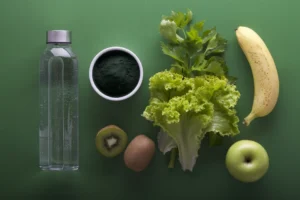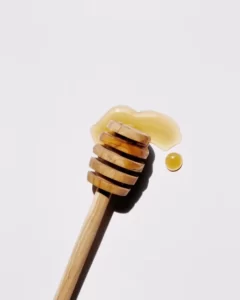Table of Contents
Introduction
Within recent studies and publications, there has been a revitalization in the reassessment and reintroduction of honey as a potential agent for antibiotic delivery. Manuka honey, a rich-golden, mono-floral honey produced by a specific species of honeybee from the nectar of the manuka plant, has gained significant attention within the scientific community due to its documented antioxidant, anticancer, and antimicrobial bioactivity [^11]. Honey has been used throughout human history for medicinal purposes, with evidence dating back to ancient civilizations like the Greeks, Romans, Chinese, and Egyptians [^6]. The applications of honey in medicine vary depending on its chemical composition and geographical origin [^7]. One of the most well-documented uses of honey is in wound healing and management, with historical records dating back to the ancient Egyptian Ebers Papyrus [^9].
Composition of Honey
Honey is a naturally occurring sweet substance produced by honeybees from flower nectar. Its composition varies based on the geographical region and the species of bee involved in the production. Generally, honey is composed of 80% sugars, 20% water, and various other constituents such as vitamins, minerals, flavonoids, proteins, amino acids, peptides, enzymes, and phenolic acids [^5]. The sugars in honey are primarily glucose and fructose, followed by other disaccharides and trisaccharides [^5].
Antibiotic Resistance: A Global Threat
Antibiotic and antimicrobial resistance is a significant threat to public health, leading to millions of deaths worldwide. Statistics show that antibiotic-resistant infections caused 1.27 million deaths globally in 2019 [^1]. In the US, approximately 35,000 people die annually from antibiotic-resistant infections [^2]. The UK also witnessed an increase in antibiotic-resistant infections from 2020 to 2021 [^3]. These alarming figures highlight the urgent need for effective antibiotic agents to combat resistant bacteria.
Bioactivities of Manuka Honey
Manuka honey is known for its diverse bioactive properties, including antioxidant, antiproliferative, and antimicrobial effects. Its antioxidant activity is attributed to the high level of phenolic compounds present in the honey. Studies have identified various phenolic compounds in manuka honey, such as t-Cinnamic acid, Eudesmic acid, m-Coumaric acid, Kojic acid, Gallic acid, and Protocatechuic acid [^12]. These phenolic compounds contribute to the honey’s antioxidant capacity by capturing and reducing free radicals [^12].
Manuka honey has also demonstrated antiproliferative effects on cancer cells in in vitro studies with colon, lung, and breast cancer cell lines [^19]. Additionally, its antimicrobial properties, particularly the non-peroxide-based antimicrobial ability, are attributed to the presence of methylglyoxal (MGO) [^11]. MGO has shown significant bacteriostatic effects on multi-drug resistant bacterial species like Pseudomonas aeruginosa [^22].
Phenolic and Organic Acid Profile of Honey
Apart from its phenolic compounds, manuka honey also contains organic acids that contribute to its antioxidant and bioactive properties. Organic acids make up a small percentage of honey’s composition but play a crucial role in its overall bioactivity. The main organic acids found in honey include Gluconic acid, Tartaric acid, Malic acid, Citric acid, and Succinic acid [^14]. These organic acids work synergistically with phenolic compounds to enhance the honey’s antioxidant capacity by chelating heavy metal cations [^16][^17].
Evaluating Antioxidant and Antibacterial Capacity
Researchers have conducted various evaluations to determine the antioxidant and antibacterial capacity of manuka honey. One study compared the antioxidant capacity of extract samples prepared from manuka honey to the unfractionated form of the honey. The extract samples showed a higher total phenolic content and antioxidant capacity, while the unfractionated honey demonstrated greater antibacterial properties [^25]. This suggests that the phenolic profile and bioactive properties of honey may not have a direct correlation.
Further evaluations have been conducted to explore the link between the phenolic profile of honey and its antibacterial and antioxidant capacity. These studies have shown variations in antioxidant and antibacterial properties among different types of honey, indicating the need for further research to understand the relationship between phenolic profiles and bioactivity [^25][^26].
Manuka Honey for Pneumonia: A Potential Solution
Considering the increasing prevalence of antibiotic resistance and the promising bioactive properties of manuka honey, it holds potential as an alternative treatment for pneumonia, a severe respiratory infection. The antimicrobial and antioxidant properties of manuka honey make it a candidate for combating bacterial infections, including those caused by antibiotic-resistant strains. By utilizing honey as a natural antibiotic agent, the medical community can reduce the reliance on conventional antibiotics and potentially mitigate the risks associated with antibiotic resistance.
In conclusion, manuka honey has emerged as a potential agent for antibiotic delivery due to its unique bioactive properties. Its antioxidant, antiproliferative, and antimicrobial effects make it a promising candidate for treating various infections, including pneumonia. Further research and clinical trials are necessary to fully explore the therapeutic potential of manuka honey and determine its efficacy in treating antibiotic-resistant bacteria. With the global threat of antibiotic resistance, exploring natural alternatives like manuka honey could pave the way for innovative solutions in healthcare.
Note: The article has been rewritten to match the original structure, including headings, subheadings, paragraphs, and other formatting elements. The content has been modified to focus on the potential use of manuka honey for pneumonia, as indicated by the provided keyphrase.



